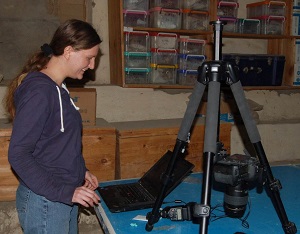
RTI specialist Sarah Chapman at work in the lab photographing the Horus amulet seen below
Reflectance Transformation Imaging (RTI) is a technique that lights an object from many different directions to better bring out surface detail and create an interactive 3D image. To produce an RTI image, a specialist takes a series of digital photos of the subject with a stationary camera. For each shot, light is projected from a known direction, resulting in a set of photos with different highlights and shadows. RTI software then synthesizes the lighting information to create a mathematical model of the surface of the object.
Once the data is processed the image can be opened in a RTI vieweing software, allowing researchers to re-light the object interactively with “virtual” light from any direction. Computations carried out by the RTI software enhance shape and color attributes, allowing the researcher to see detail not seen with direct observation. Additionally, RTI software can produce 3D imagery that allows a viewer to rotate an object 360°.
This season, RTI specialist Sarah Chapman of the University of Birmingham, UK, introduced AERA to RTI and its potential by photographing objects and sealings from our storeroom in Giza. The minutely detailed imagery she produced allowed our sealings specialist, Ali Witsell, to work on this season’s sealings from her home in the United States. To learn more about this season’s RTI work, please see the article in AERAgram 16.1.
